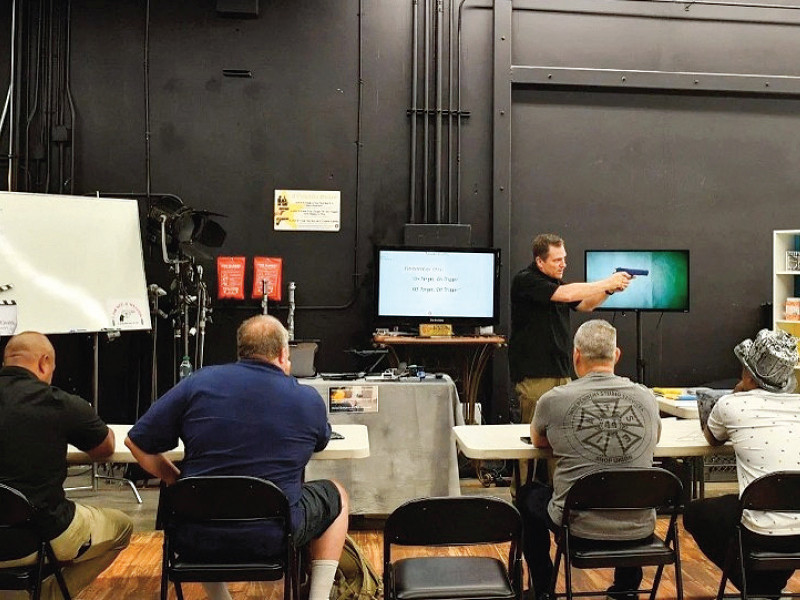
In a studio near Los Angeles, a group of filmmakers practice framing a close-up of a rubber gun held by an actor, when they are suddenly interrupted.
“He’s pointing the gun directly at the crew - it’s exactly what happened on Rust”, said Dutch Merrick, a veteran armourer who offers training on gun safety in movies. “Who’s going to raise that and speak up, if they see this situation?” he demands.
Merrick is referring to the infamous tragedy that took place in October 2021 on the New Mexico set of Alec Baldwin’s low-budget Western Rust.
That day, Baldwin pointed a prop gun in the direction of cinematographer Halyna Hutchins. He believed the revolver contained only blank bullets, but a live round struck Hutchins. Baldwin goes on trial for involuntary manslaughter this Tuesday.
“It was a wake-up call to me,” said Virginia Brazier, one of the group attending Merrick’s training course. She works as a production manager, responsible for hiring film crews, including armourers and prop masters. “I want to know what questions to ask people, to make sure that I’m vetting and doing proper recruiting to make sure that we’re safe on set,” she told AFP.
‘Golden rules’
During the course, Merrick underlines that Rust was “underbudgeted.” He believes that led to a series of failures, culminating in an “industrial accident.” He teaches students simple ways to help identify blank bullets, such as their characteristic ridged tips. And he makes attendees learn and repeat aloud the three “golden rules” of gun safety.
Always point the gun in a safe direction. Always keep your finger off the trigger until ready to fire. And always treat a firearm as if it were loaded. These are valuable basics for an industry set on edge by the Rust tragedy, said Ryan Taylor, an assistant director.
“A lot of the crew members in general are just a bit more nervous,” he said, at the workshop.
Crew members often now want to inspect props themselves, and want any rounds contained within prop guns to have been “fully shown” before use, said Taylor.
While the Rust tragedy prompted some calls for banning firearms from sets altogether, Hollywood has generally preferred less radical measures. Industry guidelines on firearm use were revised last winter for the first time in 20 years. Among other changes, they now specify that only an armourer can hand a weapon to an actor. On Rust, prosecutors said Baldwin was handed the gun by the film’s first assistant director, who later pled guilty to negligent use of a deadly weapon.
California will also require productions seeking state tax credits to hire a security advisor. The trial measure will be applied from next year, through 2030.
‘Overcorrection’
Nonetheless, some productions have decided to give up on real firearms altogether. Walker, a recent reboot of popular 1990s TV series Walker, Texas Ranger, and cop show The Rookie both used only “compressed air” guns or rubber weapons.
Action superstar Dwayne “The Rock” Johnson announced that his production company would no longer use real guns. Instead of shooting blank bullets on set, the flash and bang of gunshots would be added later using computer effects.
The extent of these changes felt across the industry is difficult to quantify. A major Hollywood prop maker, asked by AFP to confirm reports of a significant drop in gun rentals, declined to comment.
“There was a severe overcorrection, that didn’t need to be made in the way that it was,” said Merrick.
As an armourer with three decades of experience, Merrick believes that real guns - when used safely - give both actors and audiences an unrivalled sense of “authentic action.” For example, he said it is impossible for performers using rubber guns to accurately emulate the recoil of a gunshot.
Compressed air guns - or “airsoft guns,” which do not fire metal bullets - create a “false sense of security,” but could theoretically be lethal if used incorrectly, he added.
Yet with Baldwin’s trial about to begin, Merrick fears the mistrust of firearms on movie sets could be about to grow further. “It’s going to have an odd effect on performers if he’s convicted,” said Leilani Barrett, an actor attending the course.
“As an actor, I’m thinking about hitting my mark, memorising my lines, doing my character, following directions. The last thing I want to really worry about is the prop that I’m using.”


















COMMENTS
Comments are moderated and generally will be posted if they are on-topic and not abusive.
For more information, please see our Comments FAQ